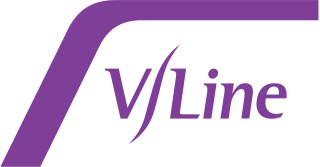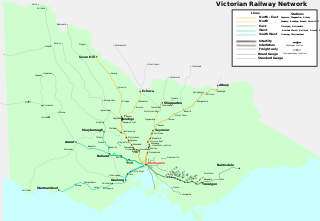
The London, Midland and Scottish Railway (LMS) was a British railway company. It was formed on 1 January 1923 under the Railways Act of 1921, which required the grouping of over 120 separate railways into four. The companies merged into the LMS included the London and North Western Railway, Midland Railway, the Lancashire and Yorkshire Railway, several Scottish railway companies, and numerous other, smaller ventures.

New Cross Gate is a railway station in New Cross, London, on the Brighton Main Line and the London Overground. It is 2 miles 70 chains down the line from London Bridge and is about 600 m (660 yd) west of New Cross station. It is in Travelcard Zone 2, and is operated by London Overground.

The Southern Railway (SR), sometimes shortened to 'Southern', was a British railway company established in the 1923 Grouping. It linked London with the Channel ports, South West England, South coast resorts and Kent. The railway was formed by the amalgamation of several smaller railway companies, the largest of which were the London and South Western Railway (LSWR), the London, Brighton and South Coast Railway (LB&SCR) and the South Eastern and Chatham Railway (SE&CR). The construction of what was to become the Southern Railway began in 1838 with the opening of the London and Southampton Railway, which was renamed the London & South Western Railway.

The Alamein line is a commuter railway line in the city of Melbourne, Victoria, Australia. Operated by Metro Trains Melbourne, it is the city's second shortest metropolitan railway line at 14.9 kilometres (9.3 mi). The line runs from Flinders Street station in central Melbourne to Alamein station in the east, serving 18 stations via Burnley, Camberwell, Riversdale, and Ashburton. The line operates for approximately 19 hours a day with 24 hour service available on Friday and Saturday nights. During peak hour, headways of up to 15 minutes are operated with services every 10-30 minutes during off-peak hours. Trains on the Alamein line run with one or two three-car formations of X'Trapolis 100 trainsets.

The Williamstown line is a commuter railway line in the city of Melbourne, Victoria, Australia. Operated by Metro Trains Melbourne, it is the city's third shortest metropolitan railway line at 16.2 kilometres (10.1 mi). The line runs from Flinders Street station in central Melbourne to Williamstown station in the south, serving 12 stations via Footscray, Yarraville, and Newport. The line operates for approximately 19 hours a day with 24 hour service available on Friday and Saturday nights. During peak hour, headways of up to 20 minutes are operated with services every 20-30 minutes during off-peak hours. Trains on the Williamstown line run with a two three-car formations of Comeng, Siemens Nexas, or X'Trapolis 100 trainsets.

The Stony Point line is a greater-metropolitan commuter railway line in the city of Melbourne, Victoria, Australia. Operated by Metro Trains Melbourne, it is the city's only diesel service on the metropolitan network and the tenth longest line at 31 kilometres (19 mi). The line acts as an extension of the Frankston line with services running from Frankston station to the small town of Stony Point in the south-east, serving 10 stations via Leawarra, Baxter, Hastings, and Bittern. The line operates for approximately ~13 hours a day with no 24 hour service available on Friday and Saturday nights—unlike other lines on the metropolitan network. Headways of 90 to 120 minutes are operated throughout the day due to limited patronage and infrastructure constraints. Trains on the Stony Point line run as two one-car formations of V/Line Sprinters.

V/Line is a statutory authority that operates regional passenger train and coach services in Victoria, Australia. It provides passenger train services on five commuter lines and eight long-distance routes from its major hub at Southern Cross railway station in Melbourne. It also provides bus services across Victoria and into New South Wales, the Australian Capital Territory and South Australia. In addition, V/Line is responsible for the maintenance of much of the Victorian freight and passenger rail network outside of the areas managed by Metro Trains Melbourne and the Australian Rail Track Corporation.

Rail transport in the Australian state of Victoria is provided by a number of railway operators who operate over the government-owned railway lines. The network consists of 2,357 km of Victorian broad gauge lines, and 1,912 km of standard gauge freight and interstate lines; the latter increasing with gauge conversion of the former. Historically, a few experimental 762 mm gauge lines were built, along with various private logging, mining and industrial railways. The rail network radiates from the state capital, Melbourne, with main interstate links to Sydney and to Adelaide, as well as major lines running to regional centres, upgraded as part of the Regional Fast Rail project.

The Victorian Railways (VR), trading from 1974 as VicRail, was the state-owned operator of most rail transport in the Australian state of Victoria from 1859 to 1983. The first railways in Victoria were private companies, but when these companies failed or defaulted, the Victorian Railways was established to take over their operations. Most of the lines operated by the Victorian Railways were of 5 ft 3 in. However, the railways also operated up to five 2 ft 6 in narrow gauge lines between 1898 and 1962, and a 4 ft 8+1⁄2 instandard gauge line between Albury and Melbourne from 1961.

Geelong railway station is located on the Warrnambool line in Victoria, Australia. It serves the city of Geelong, and it opened on 1 November 1856.
Alvie is a small town in Victoria, Australia. It is located along Baynes Road, in the Colac Otway Shire, north-west of Colac. It was named after a Scottish town of the same name, which was the birthplace of James Macpherson Grant, the Minister of Lands. It is situated in what became a rich dairying, potato and onion growing area.

Colac railway station is located on the Warrnambool line in Victoria, Australia. It serves the town of Colac, and opened on 27 July 1877.

The former Victorian Railways, the state railway authority in Victoria, Australia, built a number of experimental 2 ft 6 in narrow-gauge lines around the beginning of the 20th century. Although all were closed by the early 1960s, parts of two have been reopened as heritage railways.

The Brill Tramway, also known as the Quainton Tramway, Wotton Tramway, Oxford & Aylesbury Tramroad and Metropolitan Railway Brill Branch, was a six-mile (10 km) rail line in the Aylesbury Vale, Buckinghamshire, England. It was privately built in 1871 by the 3rd Duke of Buckingham as a horse tram line to help transport goods between his lands around Wotton House and the national rail network. Lobbying from the nearby village of Brill led to its extension to Brill and conversion to passenger use in early 1872. Two locomotives were bought but trains still travelled at an average speed of 4 miles per hour (6.4 km/h).

The Warrnambool railway line is a railway serving the south west of Victoria, Australia. Running from the western Melbourne suburb of Newport through the cities of Geelong and Warrnambool, the line once terminated at the coastal town of Port Fairy before being truncated to Dennington. This closed section of line has been converted into the 37 km long Port Fairy to Warrnambool Rail Trail. The line continues to see both passenger and freight services today.

The Crowes railway line was a 2 ft 6 in narrow gauge railway located in the Otway Ranges in south-western Victoria, Australia, running from the main line to Port Fairy at Colac to Beech Forest and later to Crowes.

The Victorian Railways' (VR) Royal Trains operated to transport members of the Royal Family on their numerous tours of Australia on the Victorian rail network. The same carriages were also used for a number of vice-regal trains for the Governor-General of Australia and the Governor of Victoria. The last Royal Train ran in 1988.
Norman Houghton is a historian and archivist in Geelong, Victoria, who has published over 30 books, many focusing on timber tramways and sawmills of the Otway and Wombat Forests of Western Victoria, Australia. Most of his works have been self-published, while he has provided numerous articles to the newsletter and journal of the Light Railway Research Society of Australia
This article outlines the history and types of passenger rolling stock and guards vans on the narrow-gauge lines of the Victorian Railways in Australia. The types were constructed in parallel with very similar designs.















